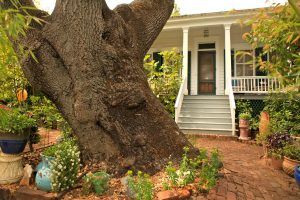Heritage Gardens: Cady House
The early days of the Gold Rush provided little time or desire for the miners to plant posies and lettuces beside their canvas tents. It wasn’t until families began joining their men out west that gardens became integrated with the daily lives of the settlers. Those who had been here for awhile were starved for vitamins from good, healthy food. They certainly must have relished benefiting from locally-grown potatoes, beans, cabbage, corn and many of the same varieties of vegetables we enjoy today.
As drug stores and medicines were unavailable, spices and medicinal plants became popular additions to gardens. Feverfew was an appropriate name for a plant used to treat high fever and “nervousness,” and the juice from red beets could be drunk as a cure for kidney stones. Babies’ colic could be soothed with catnip, and tea from the horehound plant, which was drunk to relieve the symptoms of a cold. Horehound tea was also a popular flavoring for candy.
Wagons were loaded with the few treasures from home that would fit inside, including carefully wrapped seeds, pits and cuttings for planting when they arrived here. As clippings and seeds arrived, nurseries sprang up, selling fruits and ornamental trees, grape vines and shrubs. Roses and fuchsias began to dot the landscape, as well as bulbs, berries and begonias. Abundant gardens, brimming with delicious produce and vibrant colors, were cultivated and tended with great pride.
Some of the best known vegetable gardens were grown by local Italian families, many of whom still reside in Tuolumne County. The Volponi family north of Columbia Way had what was probably the largest of the local vegetable gardens after they purchased it from the Dondero family. The Palemones grew vegetables on Lyons Street, the Gardella’s garden prospered on the property on Shaws Flat Road as well as Theall Street. The Cavaleros lived out by where the Fairgrounds are now and the Sanguinettis on Hwy 108, at what is now Sanguinetti Road.
Little is left of the gardens that provided food, beauty and even shelter from the summer’s heat so long ago. But there are still some living remnants for us to enjoy even today. The Cady Home on the corner of Norlin and Dodge Street remains an excellent example of what we would call today a heritage or historic garden.
Pam Simvoulakis-Maria, who purchased the home in 1982, and with the help of her husband, Ron Maria, have not only kept and nurtured many of the trees, shrubs, vines and perennials they inherited when the house was purchased, but they also keep in mind the grounds’ history when purchasing new plants. Old photos show the property once being ablaze with azaleas, and so the Marias have planted numerous azaleas over the years. Also growing in their yard is a grape vine that can be seen in a photograph taken in the 1880’s. Lilacs, camellias, roses, an old, but undated loquat tree, as well as a cedar tree, adorn the property. But the crown jewel of the entire yard is an oak tree that four different arborists agree must be at least 500 years old. That oak tree stood in stately witness to the Marias as they recited their wedding vows beneath it last year in May of 2014.
Doris Fuentes owns the old Morgan home on Stewart Street. Although the hardscape of the property is historic, the plantings have all been planned and grown by Mr. Fuentes and offer an excellent example of early Sonora plot designs. Her beautiful yard, even though sitting on an average size city lot, features 60 different plants, including six trees. Included in her garden are a bonsai fig, butterfly bush, roses, columbines, moonbeam and many other beautiful flowering plants.
Next week’s article will continue with descriptions of more beautiful heritage gardens that are found in the Mother Lode.
Arlene Stenger is A University of California Cooperative Extension of Tuolumne County Master Gardener.

